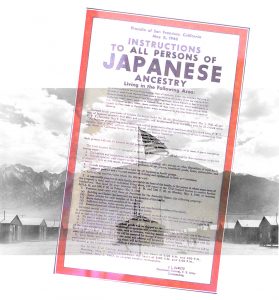 Desai: “… By now, we can accept as historical fact that the Japanese internment happened in the United States, and most people agree that it’s one of the darkest periods in American history. But the root causes of why the government so explicitly targeted Japanese Americans can be hard to parse out, so we talked to Pomona History Professor Samuel Yamashita. He said that the causes of the internment can be traced back to four distinct historical contexts, starting with the advance of European and American imperialism in the 19th century.”
Desai: “… By now, we can accept as historical fact that the Japanese internment happened in the United States, and most people agree that it’s one of the darkest periods in American history. But the root causes of why the government so explicitly targeted Japanese Americans can be hard to parse out, so we talked to Pomona History Professor Samuel Yamashita. He said that the causes of the internment can be traced back to four distinct historical contexts, starting with the advance of European and American imperialism in the 19th century.”
Yamashita: “But in most of the colonial world, life was highly racialized, and a kind of caste system based on race was created. I’m a native of Hawaii, and I was born in 1946, when Hawaii was still a colony, and the public school system in Hawaii was segregated until 1947. And you may know that President Obama went to a certain private school in Honolulu—Punohou, what was known as Punohou College. Well, there were private schools for each of the major ethnic groups.”
Tidmarsh: “The next context was the nation of Japan’s aggression, starting in 1931 with the invasion of Manchuria. This led to international outcry and sentiments against Japaese people across the world.”
Desai: “The third context was the rise of anti-Japanese sentiment in the U.S., with bans on immigration and property ownership for Japanese-born individuals. …”
Yamashita: “Now the last and smallest context is what one might call the Japanese-American context, which found that young Japanese Americans who had college degrees could not get jobs along the West Coast or in Hawaii, and so a large number of them began to move to Japan. …”
Tidmarsh: “While all of this was happening, Pomona College had started admitting students of Japanese descent from Hawaii. Professor Yamashita’s mother was actually among the students who were encouraged to apply to Pomona, although she didn’t end up attending.”
Yamashita: “Pomona College began to get students from Hawaii in the 1920s, and they were mainly from McKinley High School, the same high school that my mother went to. And I think some of the educators at McKinley High School were from the West Coast, and they were progressive, and they knew about this place called Pomona College.”
Desai: “Almost all of the Japanese American students at Pomona during the 1940s came from one of two places. Either they were from Hawaii, and they were recruited to come out to school here, or they were natives of the Inland Empire, from places like Riverside or Upland. But in spite of these policies of recruiting Japanese students, especially from Hawaii prep schools, there were very few students of Japanese descent at Pomona—probably less than a dozen at any given time.”
Tidmarsh: “The Hisanaga siblings were among the few Japanese American students during the 1940s. There were three in all who ended up attending Pomona—brothers Kazuma and Kazuo, and their sister, Itsue. They each ended up graduating with a Pomona degree, a year apart from each other but under vastly different circumstances. …”
This entire episode is available for download at soundcloud.com, iTunes or Google Play.
